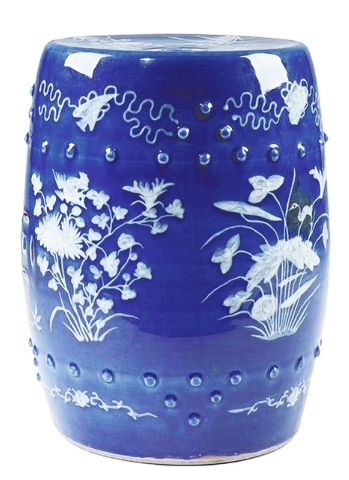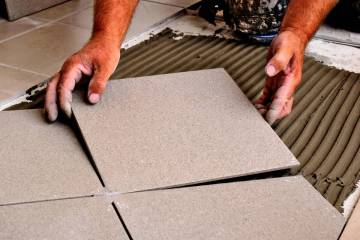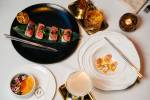Barrel-shaped seats remain popular
Garden seats shaped like a barrel are being made today from porcelain, pottery, plastic, rattan and even plaster. They are used in a living room as a coffee table, in a powder room as a pedestal to hold towels, or inside or outside as a seat.
The original antique “zuodun,” a Chinese barrel seat, was a drum made with stretched skin tops held by nails and trimmed with nailheads. Many modern barrel seats have a row of round bumps that imitate old nailheads. Most common are white porcelain “barrels” decorated with blue designs, often hand-painted.
A 19-inch-high porcelain garden stool made about 1900 sold for $1,210 at a Leland Little auction last December. The porcelain is blue with white flowers and birds. The stool has pierced decorations and bumps that resemble nailheads.
Q: When I lived in the north woods, I came across a pile of half-buried old bottles along a loggers’ road. One of them was a Dr Pepper bottle. There is no label on it, only raised letters and numbers. It reads “Dr Pepper, Good for Life.” On the back is a circle with the numbers 10, 2 and 4. The bottom reads “Fairmont, Minn.” Can you tell me something about it and if it’s worth anything?
A: The Dr Pepper soft drink was first served in Waco, Texas, in 1885 and marketed nationally in 1904. The period after “Dr” was used on and off in logos, then removed entirely in the 1950s.
Your Dr Pepper bottle dates from 1927 to 1934. During this period, embossed or “raised” logos and letters were used on the brand’s bottles, along with the bottling city’s name on the bottom. The 10-2-4 marketing idea for Dr Pepper was introduced in 1926 and stands for “Drink a Bite to Eat at 10, 2 and 4 o’clock.” The circle represents a clock dial.
Dr Pepper bottles with raised letters like yours can sell for as much as $50.
Q: I have a leaf-shaped brooch that belonged to my mother. It’s marked “McClelland Barclay.” Can you tell me when it was made and what it’s worth?
A: McClelland Barclay (1891-1942) worked in New York City as a commercial artist and magazine illustrator. He started designing jewelry in the late 1930s. His designs were made by the Rice-Weiner Co. from 1939 to 1943. They ranged from gilt-metal art moderne pieces in 1939 to sterling-silver stylized animal designs in 1943. Pieces usually were marked with Barclay’s name.
Barclay was a U.S. Navy officer during World War II. He died when his ship was torpedoed near the Solomon Islands. After Barclay’s death, Rice-Weiner made a line of jewelry called “Barclay” that was influenced by his earlier designs.
A McClelland Barclay pin sells for about $200.
Q: I would like help in placing a value on a tea set marked “Phoenix Ware, Made in England, T.F. &S. Ltd.” I have the tray, six dessert plates, six cups and saucers, the cream pitcher and the sugar bowl. Two cups are broken, but I have the pieces.
A: The mark on your tea set was used by Thomas Forester &Sons Ltd. at the Phoenix Works in Longton, Staffordshire, England. Thomas Forester opened a pottery in Longton in 1877 and built the Phoenix Works in 1879. The name of the company became Thomas Forester &Sons after his sons joined the business in 1883. The pottery closed in 1959.
Even if the set were perfect, the 21 pieces would sell for less than $100.
Q: I have a set of 14-inch-square cardboard cards titled “Your Planned Conditioning Program.” They are at least 60 years old. Each card pictures an athlete or sports star explaining how to do a conditioning exercise. Mickey Mantle, Yogi Berra and Whitey Lockman are among the baseball players. What is the set worth?
A: A complete set of the cards, including its accompanying brochure, was up for auction a few years ago with a minimum bid of $50. It didn’t sell. Someone out there might be interested in buying it, but you won’t get a lot of money for it.
Q: I have had a Hummel wall plaque of an angel and two children since the 1950s. It has the Goebel full-bee mark and the word “Germany” on the back. A wide crown mark with “WG” also is stamped on it. I learned from a Hummel price guide that the design never went into production. The book said that there are “no specimens known.” Value?
A: Your plaque is thought to be a prototype of a Hummel design called “Angel With Two Children at Feet.” Factory records say it was designed in 1938 by Reinhold Unger, but it may not have been approved for regular production. A similar production model is listed in a 1950 Goebel catalog, but not as a Hummel.
Talk to an auction house or shop that specializes in Hummels. Your plaque may be a very exciting find. Let us know what happens.
Terry Kovel’s column is syndicated by King Features. Write to: Kovels, (Las Vegas Review-Journal), King Features Syndicate, 300 W. 57th St., New York, NY 10019.




























